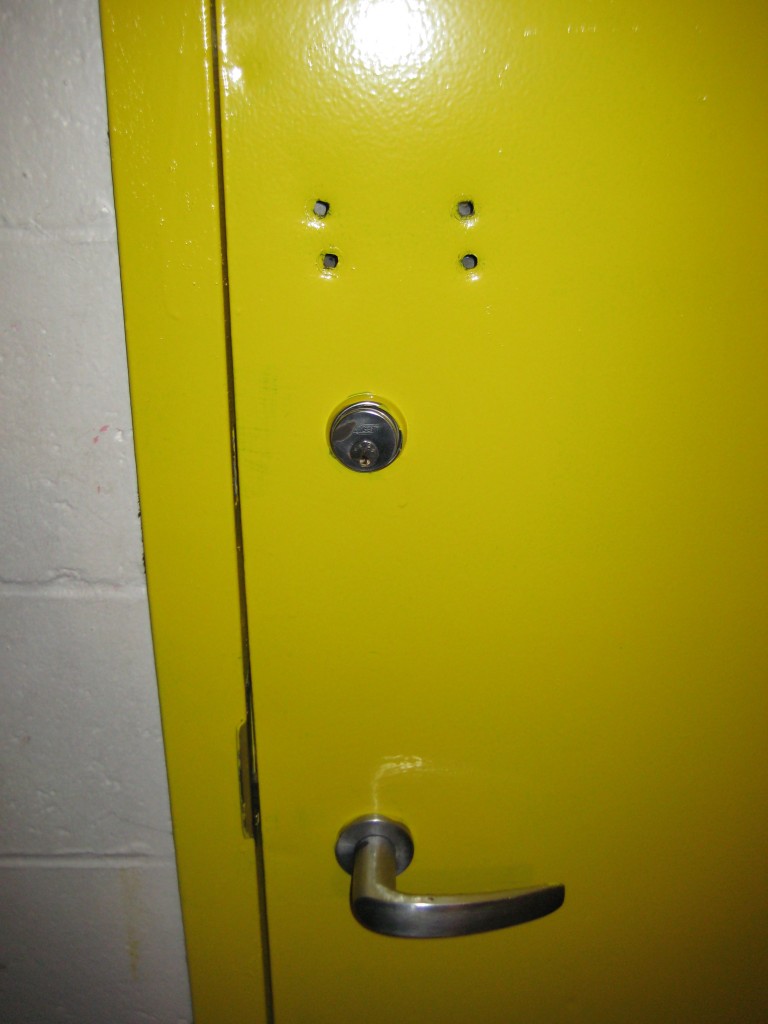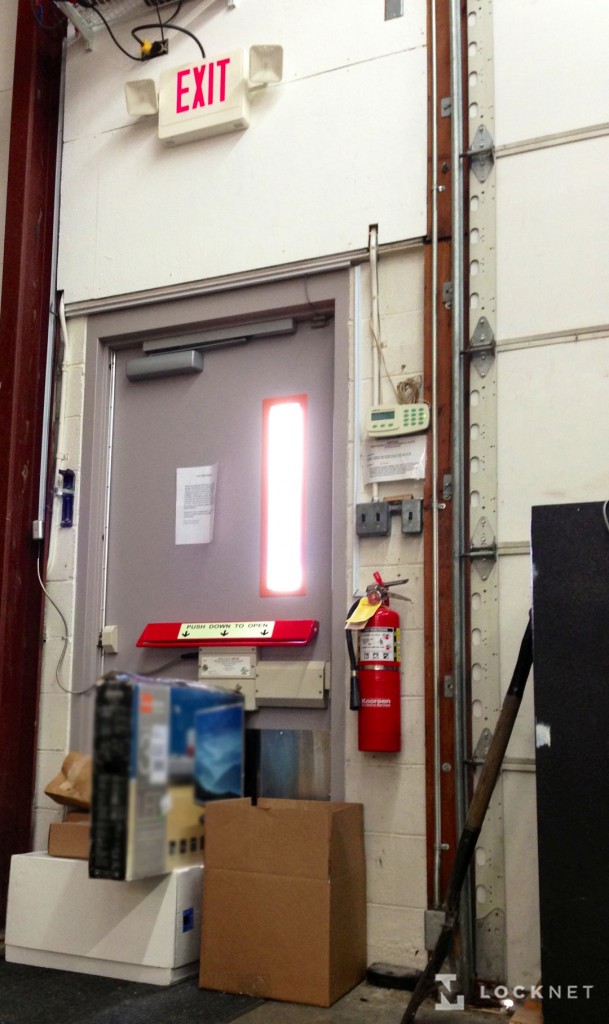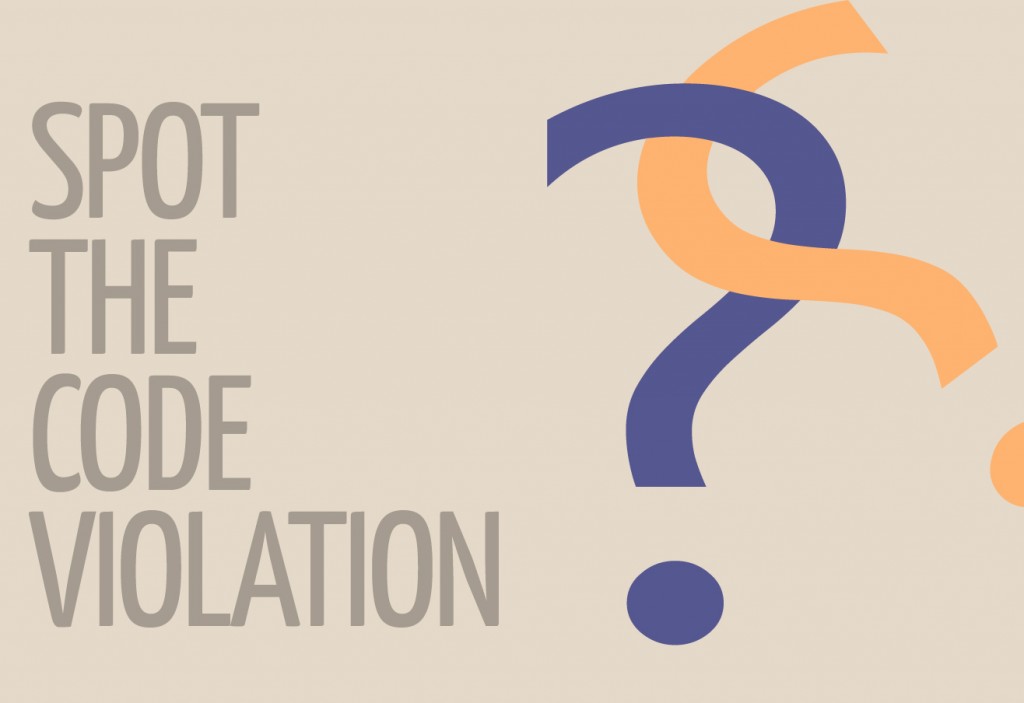 Keeping with the quiz theme this week, let’s play a game of “Spot the Code Violation.” As you know, we have talked at great length about life safety, fire, and ADA codes. Why? Because these codes drastically impact both the safety and security of your facilities, employees, and patrons, as well as your bottom line.
Keeping with the quiz theme this week, let’s play a game of “Spot the Code Violation.” As you know, we have talked at great length about life safety, fire, and ADA codes. Why? Because these codes drastically impact both the safety and security of your facilities, employees, and patrons, as well as your bottom line.
Let’s get this game started:
Can you spot the fire code violation on this fire door?
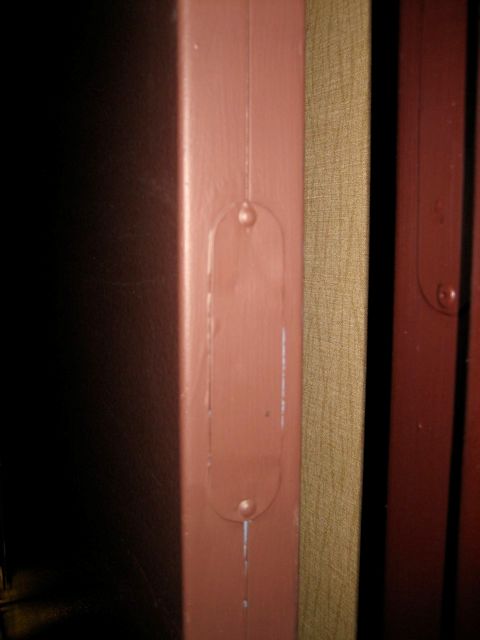 (Photo Courtesy of I Dig Hardware)
(Photo Courtesy of I Dig Hardware)
First up, I gave you an easy one – hopefully you can quickly and easily point out the problem with this fire door. You can see that something was painted over on the side of the door. Unfortunately, that something is a crucial one – the label that indicates fire rating. The following excerpts from NFPA 80 are in regard to fire-rated labels, their placement and maintenance:
NFPA 80 4.2.2 Labels shall be applied in locations that are readily visible and convenient for identification by the AHJ after installation of the assembly.
NFPA 80 4.2.3 The label or the listing shall be considered evidence that samplings of such devices or materials have been evaluated by tests and that such devices or materials are produced under an in-plant, follow-up inspection program.
NFPA 80 4.3.1 Only labeled fire doors shall be used.
Initially, the label would have been applied correctly but sometime over the years during a remodel or touch-up project, that label was painted over. The important thing to remember is that because of this single and easily avoidable mistake – the label is no longer easily visible, and the entire opening has lost its fire rating and is no longer code compliant.
This code violation should be easy to spot.
During retrofit hardware applications, holes are often left either due to removal of hardware, or because the new hardware requires a different hole pattern in comparison to the original. There is clear rectification of these unnecessary holes in NFPA 80.
NFPA 80 5.2.15.4 When holes are left in a door or frame due to changes or removal of hardware or plant-ons, the hoes shall be repaired by the following methods:
- Install steel fasteners that completely fill the holes
- Fill the screw or bolt holes with the same material as the door or frame
Common repair techniques include filling the holes with steel screws and thru-bolts, or welding a steel plate over the holes. Any products used to fill the holes must be approved and listed for that use. Currently there are very few products approved for use on fire door assemblies; common fillers like Bondo have not been approved for this use.
This code violation is a bit more egregious.
We’ve included most of the code violations I’ve discussed so far in previous articles, especially obstructed exit doors like this (staged but highly possible) blocked exit above. I ranted about blocked exits in Life Safety Considerations You (Probably) Haven’t Thought Of in October, but we continue to see them in everyday life as well as in the field. NFPA 101 has clear-cut standards for compliance:
NFPA 101 4.5.3.2 Unobstructed Egress. In every occupied building or structure, means of egress from all parts of the building shall be maintained free and unobstructed. Means of egress shall be accessible to the extent necessary to ensure reasonable safety for occupants having impaired mobility.
Let’s say there’s a fire one evening here at LockNet and this is the closest exit for the handful of employees that work in our ADHS department. What do you think will happen when they get to this obstructed door? Luckily, there’s only six in this department, so the chances of a stampede-like trampling are far-fetched. However, there will be a time consuming delay in their exiting the building. This delay has proven to be life or death, hence the inclusion in NFPA 101.
It’s important to remember that even if employees know that the storeroom exit door is inaccessible during the day, in the event of an emergency rational thought is sometimes hard to come by. Instincts take over and occupants must be able to exit quickly and efficiently, with no blockades due to improper care and/or maintenance.
There’s a life-threatening code violation on this exit door.
The quality of this image isn’t great, but there should be an easily identifiable red flag on the push plate. Do you see what I see? No – let’s take a look at that push plate close up.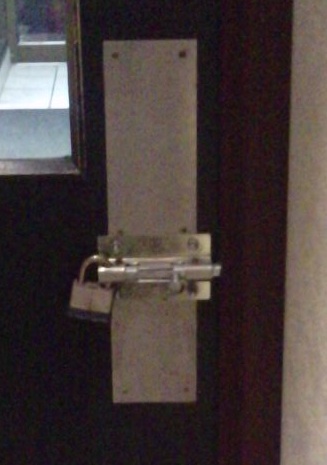
On a clearly marked exit door there seems to have been a couple of additions to the hardware set; a slide bolt as well as a dead bolt have been added to prevent exit. While it’s not uncommon for store owners/operators to restrict the use of a specific door, this falls under the same provisions as the one previously discussed.
As a marked exit door, NFPA 101 requires swift and easy single action exit from the egress side of the designated exit door. If the exit sign was removed, the hindrance of exit wouldn’t be a code issue. It’s important to note that the exit sign can only be removed with the approval of your AHJ. However, as in the case with this door, with the visible and illuminated sign – this door falls under the requirements of any other exit door. There’s a specific subsection of NFPA 101 that applies to the application of locks or makeshift locking mechanisms applied to exit doors:
NFPA 101 7.2.1.5.3 Locks, if provided, shall not require the use of a key, a tool, or special knowledge or effort for operation from the egress side.
This is, by no means, an all-encompassing list of common violations, but they do seem to be some of the most frequent violations. Hopefully we will be an ever-present reminder to keep your exits unobstructed, and unlocked, holes from renovations or retrofits filled, and labels easily visible.

